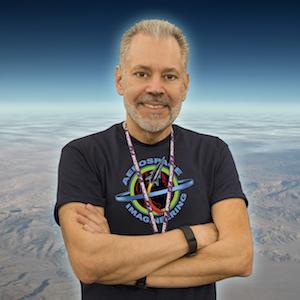Exploring the Boundaries of Art, Design, Aerospace Engineering & Popular Culture
Art and Illustration play an important role in the world of aerospace engineering design and development. Envisioning what advanced air and spacecraft concepts might look like facilitates the systems engineering process. Visually communicating such ideas also enhances public awareness, understanding and engagement, and inspires future generations. In my experience, the development of real aerospace vehicle system configurations is very much an interdisciplinary combination of engineering and art. A successful aerospace vehicle configuration design cannot be achieved purely by any algorithmic or quantitative methods that I am aware of. You certainly have to do the math but there’s much more to “packaging” a workable vehicle than that. It’s the perfect example of Art and Science working together, requiring considerable creativity and ingenuity. Public perception of what constitutes a “real” spaceship is probably driven by the fanciful creations of Hollywood as much as reality. Why are spacecraft and other technology driven aerospace vehicles shaped the way they are, both in fiction and reality? How does Hollywood’s design and development process for the depiction of future technology differ from reality? I will show how I managed to blend art and engineering to great advantage throughout my technical career in aerospace engineering as well as my Hollywood consulting experience.
Technical Talk: Careers in Aerospace — Forging a Flexible Path Forward
The always-evolving aerospace industry offers challenging and diverse career paths at the forefront of advancing technology. What do you need to know and learn to pursue a rewarding and sustaining career in aerospace? Some knowledge of where the industry came from will help you plan your own career path. The modern aerospace industry and the discipline of systems engineering were forged in the post-World War II and Cold War environments. NASA’s formation in 1958 was followed by a period of unprecedented scientific discovery and exploration. A widespread aerospace industry consolidation occurred in the 1990s as the Soviet Union collapsed and the Cold War came to an end. Such profound political changes as well as evolving economic factors forced the industry to adapt. The aerospace business is now driven by the complex realities of the world we live in and the dawn of the Second Space Age, fueled by new technology developments and both private and government space exploration initiatives. For anyone working in this business, constant change is likely. For those interested in pursuing a career in aerospace, what options are available and what are the factors to be considered?
Bio:
Aldo Spadoni is an MIT graduate with an aerospace engineering career spanning over 35 years. He has made significant technical contributions to numerous advanced aircraft, missile, and spacecraft programs for NASA, DARPA, and the U.S. Armed Services. He began his engineering career at Hughes Space & Communications Group as a spacecraft configuration design engineer working on the Galileo Jupiter spacecraft. Later, he joined TRW Defense & Space Systems as a navigation systems engineering specialist working on ICBMs and spacecraft programs. Aldo joined Northrop in 1985, supporting the advanced design team in the area of advanced avionics system integration and project management. He created and managed an award-winning creative simulation team at Northrop Grumman Aerospace Systems. Aldo is a recipient of NASA’s 2004 Turning Goals Into Reality team award for Reusable Launch Vehicle Development. He is an accomplished self-taught artist and concept designer with four U.S. patents to his credit. He is a Fellow of the International Association of Astronomical Artists (IAAA) and is currently serving on its Board of Trustees. Aldo’s consulting company, Aerospace Imagineering, specializes in the conceptual design, visualization and prototyping of advanced technology products and concepts. His visualizations have appeared in numerous magazines and television documentaries. He has worked closely with hard science fiction authors such as Larry Niven and Jerry Pournelle to bring their technological visions to life. As an aerospace concept designer and technology consultant to the entertainment industry, he supported the production of Apollo 13, Supernova, Stealth, Iron Man 1 & 2, and other movie projects. He helped produce the 2009 National Geographic Channel documentary called Hitler's Stealth Fighter. Aldo’s personal goals are to promote STEAM education and create compelling visions of humanity’s spacefaring future.
